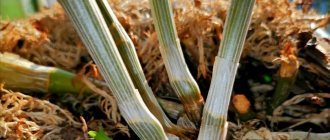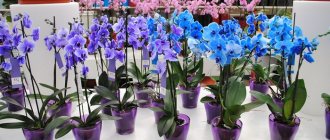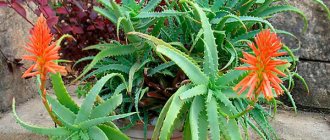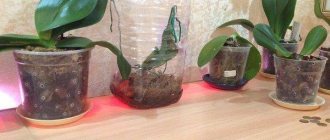This exotic beauty orchid is so attractive and unusual! Happy gardeners bring home this little joy, admire the delicate cluster of buds, and when the plant has bloomed and goes into dormancy mode, they wait again with bated breath...
If phalaenopsis does not bloom, what should I do? Your green pet needs special conditions to re-grow the flower stalk and bloom with delicate petals.
Bloom
Reasons for absence
The most precise formulation of the problem is inappropriate conditions. Flowering is a sign of plant health.
After the purchase
It takes time to get used to new conditions after purchase. A change in habitat is in itself a big test for a plant.
In nature, a flower stays in one place all its life, in a familiar environment. When the temperature regime, lighting angle, and substrate temperature change sharply, the plant has to rebuild the functioning of its tissues.
Transportation of a plant always leads to microtraumas of leaves and aerial roots, even very carefully. Also, during the “travel” there is often additional stress in the form of temperature changes.
The green pet needs to be created with optimal living conditions, close to natural ones , and given time to heal damage and adapt in general.
It is impossible to say exactly how long it will take. You can focus on a period of 12 months. If flower stalks still do not appear, it’s time to take action.
If the plant does not develop at all
If the plant has stopped developing as a whole, does not grow new leaves and, especially, does not bloom, you should start with general care and check the conditions of the plant. If properly cared for, stimulation of flowering is not necessary at all.
Substrate
tree bark is used as a substrate , then such material should not be fresh . It should also not contain fresh sawdust. Substances made from such materials are harmful to orchids.
Tree bark as a substrate.
In winter, the plant may stop growing and blooming due to living on a cold windowsill. If there is no other place for placement, you need to organize at least a stand.
IMPORTANT! In summer, the intensity of solar radiation goes off scale and can even cause burns on delicate leaves. Indeed, in its native tropics, the phalaenopsis orchid grows in the dense undergrowth of the jungle, where there is no direct sunlight. To avoid such unpleasant consequences, it is worth protecting the plant with blinds or any available method.
Lighting
In winter, when daylight hours are short and dim, the orchid may “starve” because there is not enough sunlight for the full process of photosynthesis.
During this difficult period, the tropical plant needs additional lighting.
This is easy to organize with the help of specialized phytolamps. These lighting devices emit a spectrum of light waves that are most favorable for the process of photosynthesis.
IMPORTANT! In summer, the intensity of solar radiation goes off scale and can even cause burns on delicate leaves. Indeed, in its native tropics, the phalaenopsis orchid grows in the dense undergrowth of the jungle, where there is no direct sunlight. To avoid such unpleasant consequences, it is worth protecting the plant with blinds or any available method.
Watering
Excessively abundant watering will not bring any benefit, as will extremely infrequent watering. When there is too much water, it can stagnate in the pot and rot can form on the roots. In this case, the exhausted plant has no chance of flowering.
Insufficient watering is not so harmful , it can even imitate the dry season in the tropics, but still should not be overused.
Determining the frequency of watering.
Top dressing
When phalaenopsis just begins to produce new leaves, this is an excellent moment for feeding. Flower buds, from which flower stalks will subsequently appear, are laid simultaneously with new leaves.
If such a moment is missed, and in addition the watering was incorrect, weak buds will be formed that have nothing to please.
Diseases and pests
Keeping an orchid in a residential area carries the risk of contracting diseases or pests.
If the phalaenopsis has not bloomed for 2 years or longer, it is quite possible that it is simply trying to survive under the onslaught of spider mites , which suck out all the juices.
It is useless to try to force phalaenopsis to bloom in such a situation; cure it first.
External signs of readiness
You should not be tied to the time of year to determine when phalaenopsis will bloom. This tropical miracle can bloom all year round; it comes from warm regions where winter does not occur. You just have to organize suitable conditions for him.
The age of the phalaenopsis from the moment when the baby was placed in a separate container must be at least two years. The plant should gain strength and produce four to six large leaves and a large, strong root mass.
Healthy leaves
The plant is full of health. The color of the green mass is fresh and rich. The leaves are shiny, with pronounced turgor.
Strong healthy leaves.
Roots
The roots are normally green and clean, without dark spots . Lots of aerial roots. A clear, clean pot free of green algae.
Secret 5 – Feeding
Due to the fact that in the wild, orchids obtain nutrients from the air or dew, when growing them indoors, the same feeding conditions should be created - by spraying them from a spray bottle onto the leaves or adding them to water for irrigation. To prevent leaf burns, the plant should be watered abundantly two days before the planned feeding. Water with complex mineral fertilizer should have a temperature above room temperature, the amount of fertilizer should be two times less than stated in the instructions.
During feeding, care should be taken to ensure that the plant is not exposed to direct sun and is not exposed to drafts. To carry out the procedure, the pot is lowered into a container filled with water and fertilizer for 15 minutes, then pulled out. After irrigation, all droplets collected in the axils of the leaves are blotted with toilet paper or a paper napkin. During flowering, fertilizing is not carried out; you should wait until it ends. It should be taken into account that untimely feeding can cause the buds to wither.
The flowering of the plant lasts for three months, some varieties bloom for 7-8 months. Fertilizing should begin from the beginning of active vegetative growth of leaves and peduncles until the formation of the first bud. In order to get rich green leaves, you should take nitrogen-containing fertilizers, and if you want to get abundant flowering, select potassium and phosphorus-containing fertilizers. These elements contribute to the formation of more buds, and also strengthen the flower’s immunity to unfavorable growing factors. Phosphorus activates flower growth and has a beneficial effect on the root system. If the fertilizer contains magnesium and boron, all the main elements will be absorbed much better. It is not recommended to feed recently purchased or transplanted plants, as they still contain a sufficient amount of nutrients in their soil. For feeding, special preparations are purchased such as “Greenward”, “Bona Forte”, “Kemira Lux”, “Substral”, “Flora” and others.
How to make a phalaenopsis orchid bloom at home?
Let's talk about how to stimulate flowering using various methods.
Primary
Do not change location during budding period
Changes in lighting have a negative effect on the orchid. The plant has to rebuild the cellular structure of tissues, adapt previously poorly illuminated parts to intensive photosynthesis.
The resources necessary for flowering remain scarce, and flowering will be delayed until better times.
If you constantly twist and rearrange the pot, you may not wait for this joyful event. Special attention should be paid to seasonal changes in natural light.
Transparent pot
Orchids are unique plants that have aerial roots. These shoots have the ability to absorb moisture directly from the air, despite their thick, gangly appearance.
The main distinctive ability of such roots is that they participate in photosynthesis in the same way as leaves, and it’s not for nothing that they are the same color.
Of course, stores now offer such an assortment of flower pots in all the colors of the rainbow that it’s a shame to plant an orchid in an unremarkable transparent container . But that’s exactly what she needs!
The best pot for phalaenopsis is transparent.
Attention! If plants of other families receive nutrients only from the leaves, then this unique plant among flowers produces chlorophyll literally with its entire body. An opaque pot will immediately deprive the orchid of half its nutrients.
Additional lighting in autumn-winter period
In winter overcooling should be avoided , so a cold windowsill is not the best place for a delicate plant. A stand is needed so that there is an air gap between the cold surface and the roots of the plant.
For optimal lighting, it is rational to use economical LED phytolamps, which will provide plant cells with light of the red and blue spectrum. This is the light that is best suited for photosynthesis.
Day and night temperature difference (as in nature)
In tropical forest conditions, the difference between day and night temperatures is about 5 degrees Celsius . It is precisely this difference that can provoke the beginning of the growth of peduncles in phalaenopsis.
Repeatedly
The use of chemicals for stimulation
succinic acid
Succinic acid gently revitalizes the entire plant and is safe even in case of overdose:
- Prepare a solution based on 500 ml. clean water and 1 tablet of succinic acid (or the amount on the tip of a knife, if in powder);
- Spray the plant completely and water with the rest.
After treatment, the phalaenopsis will begin to produce new leaves and roots, take root and begin to bloom.
Succinic acid heals phalaenopsis.
Epin
This remedy helps the plant cope with stress and adapt to new conditions.
The leaves are sprayed with this preparation, but not watered.
Stimulating dormant kidneys with cytokinin paste
A powerful method of influencing dormant kidneys. The essence lies in the action of the phytohormone cytokinin, which helps not only to awaken the bud, but also to grow from it a healthy, strong peduncle with many buds.
Cold and hot shower
A contrast shower imitates tropical rains and also removes impurities from the surface of the plant. If there are spider mites on the leaves, the flow of water will wash them away.
A contrast shower will help stimulate flowering.
Carefully! If the water temperature is above 35 degrees Celsius, you can burn the plant. In general, this is a fairly harmless method for a healthy plant, but during the budding phase it can cause significant harm, because even turning the pot is not recommended.
Secret 1 - Age of the orchid
When purchasing a flower in a store, you cannot accurately determine its age, so with proper care, without seeing it bloom, we get very upset. This may indicate that you bought an old or very young plant. If the flower is old, it is almost impossible to achieve flowering, but if it is too young, you need to continue to properly care for it and after some time it will definitely thank you with bright, beautiful flowers. The most blooming orchids are Dendrobium and Phalinopsis. They are the ones that can most often be seen in flower shops.
The best age for the formation of buds is considered to be 2-3 years. However, some varieties are able to bloom at the age of one year. It is at this time that the bud formation functions are launched and the plant begins to spend energy on the development of buds and flowers. By this time, the stems should have from 5 to 7 leaves, and the plant should be grown in favorable conditions, healthy and strong. If you provoke flowering at an earlier age, this may lead to the death of the flower, since by that time it will not be able to accumulate enough strength to form buds. When buying an orchid, pay attention to the number of mature leaves on it. They will tell you the approximate age of the flower.
No flowering
After transplant
Root system disorders
During transplantation, the plant experiences short-term but very painful stress. Cut off diseased roots should be sprinkled with crushed activated carbon to avoid the appearance of rot.
Until the plant grows its usual root mass, it will not have the strength to flower.
The soil does not support the flower
Perhaps the substrate is overly compacted and disrupts the movement of nutrients in the roots. The opposite situation, when the plant is “dangling” in a pot , also does not bode well.
After bringing the substrate to the normal fullness of the pot, the phalaenopsis will gain the required mass of roots and will be able to bloom.
Correct position of roots in the pot.
After trimming
The main problem after pruning is that there are no leaves and no flower buds in the axils. They need to be re-grown. A small amount of green mass is associated with a lack of nutrients.
It is necessary to treat with succinic acid or epin , and when the plant begins to grow, continue feeding with complex fertilizer for orchids. When the number of leaves reaches five or six, flower stalks may appear.
Secret 4 - Watering
During the development of buds, the flower should be watered moderately. To do this, you need to wait until the soil in the pot dries completely. This is due to the fact that during flowering, specimens that grow in the wild adjust to the pollination period. Pollinating insects usually do not fly during the rainy season, so irrigating the plants is not recommended. You need to water the orchid with water that has been standing for several days, heated to a temperature of 36 degrees. This is due to the fact that in the wild growing environment the raindrops that fall on the leaves have exactly this temperature.
It should be borne in mind that waterlogging has a bad effect on the buds; they can dry out and crumble. Before the flower is about to bloom, reduce the frequency of watering. Some types of crops prefer dried soil during flowering. In order to determine whether an orchid needs to be watered or not, pay attention to its leaves - if they become wrinkled, this indicates that the plant does not have enough moisture. After you water it, the leaves will straighten out and all the wrinkles will disappear. In winter, the flower pot is placed on a foam mat to prevent hypothermia of the lower roots. Moisten the orchid from below by placing the pot in a container of water, after all the soil is wet and the roots are saturated, drain the water from the container.
Unsuitable substrate
The quality and composition of the substrate in which the orchid grows plays an important role in its flowering. In an unsuitable substrate, plants experience discomfort and do not bloom. A suitable substrate for capricious beauties is a mixture consisting of the following components:
- sphagnum (moss);
- crushed pine bark;
- vermiculite;
- clean coarse sand;
- peat.
This mixture will ensure complete air exchange and oxygen access to the roots.
Temperature violation
Beginning flower growers also encounter situations when the orchid has already passed the growing season and even sent out a peduncle, but suddenly acquired a sickly appearance and stopped its development. Such situations often occur when the temperature regime is violated
It is important to consider that the tropical origin of these exotic beauties requires appropriate conditions and the absence of strong temperature changes. These plants feel most comfortable at a temperature of about 20°C.
A drop in air temperature to +10°C is a severe stress for them, as a result of which exotics can stop the development of flower buds and even die.
Unsuitable substrate and air humidity
Tropical forests are characterized by high air and soil humidity. With a lack of moisture in the air and substrate, orchids experience stress, as a result of which they can stop the formation of peduncles and buds and even die. To prevent the leaves and roots of these capricious exotics from drying out, you should ensure that the substrate in the pot is constantly moderately moist. However, it is unacceptable to flood the plants, since waterlogging of the substrate leads to rotting of the roots. To maintain optimal air humidity, orchids are regularly sprayed with warm water from a spray bottle, and a wide plate or bowl of water is placed near the pots. As moisture molecules evaporate, they will saturate the air, which will have a beneficial effect on the condition of the plants.
Plant diseases or pest damage
Very often, orchids are attacked by pests and pathogens of various diseases, which can not only stop flowering, but also lead to the death of the plant
To prevent this, it is important to inspect each flower regularly. Most pests (aphids, whiteflies, thrips) are visible to the naked eye
Very small parasites can be detected by examining the orchid with a magnifying glass.
During the inspection, it is important to assess the condition of the plant, note the presence or absence of strange spots and signs of rotting on it. All parts of the plant must be inspected - leaves, buds, peduncles, children and roots
How does it begin to open up?
In the axils, between the leaves, on the stem of the plant, there are dormant buds, which, under conditions close to natural (with normal care), can develop into a peduncle or give off lateral shoots. Sometimes inexperienced gardeners confuse flower stalks with aerial roots.
Important! During the formation of the peduncle, under no circumstances should the Orchid be subjected to stress. In the case of the simultaneous appearance of a peduncle and a new leaf, it is best not to interfere and let the plant independently choose what is best for it to develop
In the case of the simultaneous appearance of a peduncle and a new leaf, it is best not to interfere and let the plant independently choose what is best for it to develop.
Darkness
One of the most popular methods involves creating a stressful situation for the orchid. It will work if the plant is healthy. To do this, use the absence of lighting.
Phalaenopsis with dry soil is placed in a dark place for 5 - 6 days. Sometimes it takes longer - up to 14 days. Place the pot in a closet or pantry, for example. The plant is then exposed back to the light. This measure provokes the formation of buds.
Due to the stress experienced, the orchid should release a flower arrow in three weeks. This is due to the activation of vital forces.
Pollination of a plant
Under natural conditions, plant pollination depends on the season during which flowering buds formed. It should not be forgotten that the natural habitat of orchids is Thailand, which is famous for its rainy seasons, which last several months, but during the rest of the time the flower can only get moisture from the air.
Based on this, some experts are convinced that further flowering is simply impossible without additional moisture. But achieving the necessary indicators in an apartment is not at all easy.
Many gardeners have noticed that plants purchased at certain times of the year bloom better, but others may not produce flower stalks throughout the year. The solution to this phenomenon was found, but it was not easy to do.
Scientists have noticed that flowers have biological memory. It happens that a flower began to bloom, for example, in February, and dropped its buds, say, in April, without expelling new buds.
In this case, the appearance of flowering should be expected no earlier than the beginning of next year. But, with proper care, orchids can set buds throughout the year.
Possible pests
The cause of sticky drops on orchid leaves may be external manifestations of pests:
- Mealybug. It can be confused with the scale insect. It can appear not only on the plant, but also nearby, on the soil. Larvae and adults bite into leaves and stems and suck out the juice. They leave behind sticky marks. Toxic enzymes secreted by scale insects enter the vessels of plants. The plant weakens and may die.
- Aphid. You can recognize it by its curled sticky leaf and wilted flower stalks. Aphids suck the juice from the leaves, causing them to gradually die. If measures are not taken, secondary infection with sooty fungus may occur. It is better to destroy the pest with insecticidal preparations, but before doing this, wash the shoots with a solution of soap and tobacco.
- A miniature white butterfly - whitefly. She gnaws through the top layer of orchid tissue and sucks out the juice. It leaves behind transparent nectar and yellow stains. Many gardeners save orchids by hanging flypaper around them to prevent flies, but if you don’t have time, the butterfly that has settled on the plant lays eggs, and the fight against it becomes more difficult. Any insecticide will help against whiteflies. After spraying, the plant is placed under a film so that not only the adults, but also the larvae of the pest die.
- Shield. The pest reproduces very quickly; females store their eggs under their shell. The hatched larvae are able to move. They crawl along the shoots, looking for a place where they can attach with their proboscis and remain until they reach adulthood and lay eggs. The food of the scale insect is the sweet juice of phalaenopsis. If you water the soil in a flowerpot with an enteric-contact insecticide. The scale insect will suck out the poisoned juice, which will provoke its death.
Orchid pests











